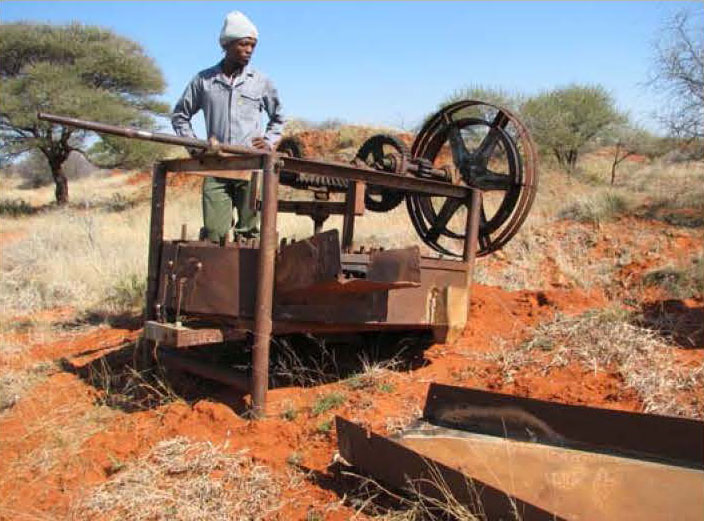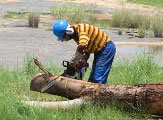Heritage impact assessments are a means to facilitate development while ensuring that what should be conserved is saved from destruction, or adequately mitigated and/or managed.
The Northern Cape Province boasts an enormous wealth of archaeological sites and resources, providing perspectives on our past that are not available in any other, written or oral, form. Many are of national or even international significance. These resources are unique, non-renewable and fragile. They are highly susceptible to damage by agriculture, mining and development.
Impacts
Development projects and mining can impact negatively on archaeological and historical sites directly and indirectly. Indirect impacts could include associated infrastructure development, eg roads, powerlines, and consequent urban and industrial development.

More than a million years
Archaeological sites in the province cover more than a million years of human history.
- Early hominid remains up to 2,7 million years old have been found along the Ghaap Escarpment and the West Coast, and their occurrence may be more widespread.
- Stone Age sites – ranging from Earlier to Later Stone Age times – occur richly throughout the province. While often concentrated along rivers or around pans, sites are found in every part of the landscape. Rock art occurs in the form of engravings on hills or plains in the interior, and paintings in caves and shelters along scarps or in mountainous areas.
- Herder sites are found particularly in settings near rivers and along the West Coast where evidence of pastoralism is known that dates from at least 2000 years ago.
- Agriculturist sites are found mainly in the north eastern part of the province. A westward extension of Tswana settlement in the southern Kalahari/Orange River Basin as far west as Upington is documented prior to 1800, when climate may have been more favourable.
- Archaeological and cultural resources of the colonial era include historic buildings or ruins of farms, missions, mines, settlements and associated ash heaps; sites of forced removals; also early irrigation developments such as the Orange River canals.
- Historical resources also include burial sites, battlefields, movable and immovable structures and objects, oral histories and traditions, natural features or landscapes imbued with cultural or religious significance, place names, social and economic processes and domesticated plants and animals.
Protection and conservation
The National Heritage Resources Act (No 25 of 1999) provides for the protection and conservation of heritage resources including all archaeological sites. Environmental legislation integrates heritage and cultural resources into environmental management processes.
Surveys and impact assessment
Only a fraction of all archaeological and cultural heritage sites in the province are documented.
The Seekoei Valley – one of the few areas systematically surveyed – contains some 16 000 known archaeological sites. Even given variability in densities of sites per region, extrapolation from this figure indicates a massive likely province-wide total.
The chances are that any given development will have an impact on archaeological or cultural heritage sites. It is essential therefore that the potential impacts of any development should be assessed by a professional archaeologist at the earliest possible phase of project planning.


A register of professional CRM (Cultural Resource Management) practitioners in archaeology – and their fields of competence – is maintained by:
Association of Southern African Professional Archaeologists
The McGregor Museum Archaeology Department provides Archaeological and Heritage Impact Assessments.
email: dmorris@museumsnc.co.za
PO Box 316, Kimberley, 8300
Tel: +27 (0)53-839 2700/6
Fax: +27 (0)53-842 1433
Preliminary surveys should be undertaken well in advance of construction to avoid costly delays. Additionally, archaeological material may be exposed during construction.
Sites vary in degree of preservation and overall significance: it may be important to save some more than others. In most cases development should be able to proceed as planned after the sites have been recorded. In some cases mitigation may be recommended. This may involve excavation or collection of archaeological material and evidence for record and research purposes. More rarely, sites of exceptional importance may call for preservation in situ and thus modification of the proposed development.
Permission for development to go ahead is granted by the South African Heritage Resources Agency (SAHRA) once it is satisfied that steps have been taken to safeguard archaeological or cultural heritage sites, or that they have been adequately recorded and/or sampled.
“The South African central plateau is unique in the world…in that it supported large numbers of non-farming people who were also prolific makers of stone tools until very recent times. A brief comparison of surveys conducted elsewhere in the world reveals promptly and unambiguously that SouthAfrica is richer in Stone Age remains than any other place on earth.” (C.G. Sampson, Seekoei Valley survey, 1985).
“It is a great and spectacular history when compared to any other place in the world”
Sustainable development
Environmental policy safeguards the cultural environment in a framework of sustainable development. Heritage resources are important in other sectors including education, tourism and recreation.
Legislation
The National Heritage Resources Act (No 25 of 1999) (NHRA) provides protection for archaeological resources.
It is an offence to destroy, damage, excavate, alter, or remove from its original position, or collect, any archaeological material or object (defined in the Act), without a permit issued by the South African Heritage Resources Agency (SAHRA).
Section 35 of the Act protects all archaeological and palaeontological sites and requires that anyone wishing to disturb a site must have a permit from the relevant heritage resources authority. Section 36 protects human remains older than 60 years.In order for the authority to assess whether approval may be given for any form of disturbance, a specialist report is required. Nomining, prospecting or development may take place without heritage assessment and approval.
SAHRA at national level acts on an agency basis for the Provincial Heritage Resources Agency (PHRA) in the Northern Cape, where archaeological sites are concerned. Permit applications should be made to the SAHRA office in Cape Town.
Northern Cape Rock Art Trust
Public Archaeology and Mining
The McGregor Museum Archaeology Department is committed to promoting public appreciation for archaeology as a means of understanding the past.
One thrust of our efforts in this direction has been to increase the awareness of archaeology amongst the mining community whose operations disturb sites, especially along the rivers. Participation in the regrettably now defunct Kimberley Mining Multi-Stakeholder Forum, part of the KWAGGA Project in the late 1990s, improved interaction between all parties.
Contacts and information
Development planners should engage with archaeological and heritage resources researchers and/or managers at:
SA Heritage & Resources Agency: The Regional Manager,
PO Box 1930 Kimberley 8300
Tel: 053 831 2537
Fax: 053 833 1435
email: sahra_nc@iafrica.com
SA Heritage & Resources Agency: Head Office
PO Box 4637 Cape Town 8000
Tel: 021 462 4502
Fax: 021 462 4509
email: mleslie@sahra.org.za
Archaeology Department McGregor Museum
email: dmorris@museumsnc.co.za
A register of professional CRM (Cultural Resource Management) practitioners in archaeology – and their fields of competence – is maintained by: Association of Southern African Professional Archaeologists
